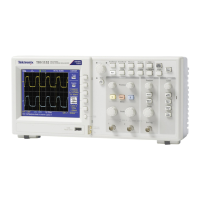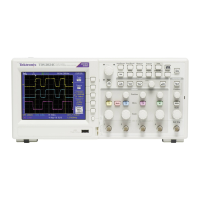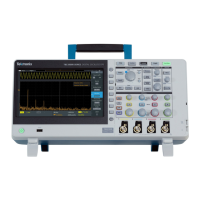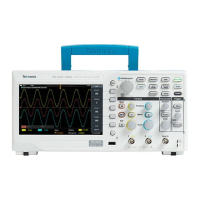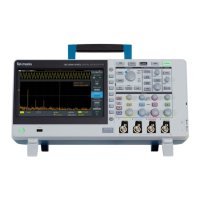Reference
Source Options
.
Source option Details
Ch1, Ch2 Triggers on a channel whether or not the waveform is
displayed
Ext Does not display the trigger signal; the Ext option uses the
signal connected to the Ext Trig front-panel BNC and allows
a trigger level range of +1.6 V to -1.6 V
Ext/5 Same as Ext option, but attenuates the signal by a factor of
five, and allows a trigger level range of +8 V to -8 V; this
extends the trigger level range
AC Line
1
Uses a signal derived from the power line as the trigger source;
trigger coupling is set to DC and the trigger level to 0 volts.
You can use the AC Line when you need to analyze signals
related to the frequency of the power line, such as lighting
equipment and power supply devices; the oscilloscope
automatically generates the trigger, sets the Trigger Coupling
to DC, and sets the Trigger Level to zero volts.
1
Availab
le only when you select the Edge trigger type.
NOTE. To view an Ext, Ext/5, or AC Line trigger signal, push and hold down the
Trigger Menu button for more than 1.5 seconds to enable trigger view.
Coupling. Coupling allows you to filter t he trigger signal used to trigger an
acquisition.
Optio
n
Detai
ls
DC Pass
es all components of the signal
Noise Reject Adds hysteresis to the trigger circuitry; this reduces sensitivity
whi
ch reduces the chance of falsely triggering on noise
HF Reject
Att
enuates the high-frequency components above 80 kHz
LF Reject
Bl
ocks the D C component and attenuates the low-frequency
components below 300 kHz
AC Blocks DC components and attenuates signals below 10 Hz
NOTE. Trigger coupling a ffects only the signal passed to the trigger system. It
d
oes not affect the bandwidth or coupling of the signal displayed on the screen.
Pretrigger. The trigger position is typically set at the horizontal center of the
screen. In this case, you are able to view fi ve divisions of pretrigger information.
Adjusting the horizontal position of the waveform allows you to see more or less
pretrigger information.
98 TBS1000B and TBS1000B-EDU Series Oscilloscopes User Manual
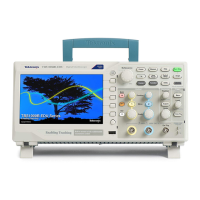
